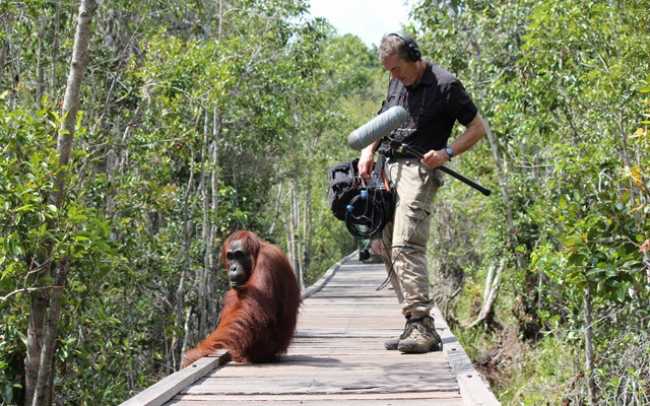DPA captures sound for The Last of the Great Apes film shoot
Published: ASIA

ASIA: Sound designer Craig Carter chose a DPA 5100 mobile surround microphone and a DPA 4017B shotgun mic with a Rycote windshield solution for 15 weeks of location filming for the feature-length documentary The Last of the Great Apes. The recording process saw Mr Carter visit Indonesia, Sumatra, Borneo and Africa.
Produced by Australian film company Visionquest Entertainment, The Last of the Great Apes will be released in cinemas and supported by a six-part TV series.
The 5100 was chosen to capture surround ambience, whilst the 4017B and Rycote combination was utilised on a long boom so that sound could be captured without disturbing the animals.
‘After taking some very helpful advice from Julius Chan at DPA’s Australian distributor Amber Technologies, I chose the DPA 5100 surround microphone for its sound pressure capabilities and its ease of use in the conditions I was working in,’ Mr Carter explained. ‘Thanks to its compact size and extreme portability, it was ideally suited to these challenging conditions. Also, the DPA 5100 has only one multicore cable, which was an important consideration because I was mainly recording and booming on my own. Having lots of cables to worry about would have made the task way too difficult.
‘The 4017B was easy to mount quickly and had an excellent signal to noise ratio,’ he continued. ‘Because it is very directional it was easy to eliminate unwanted sounds and was certainly my first choice of microphone for shots where there was a lot of background noise. It's also very light, which counts when you’re booming in an awkward position for any length of time. And of course, it was reliable. I didn't have any issues with it at all.’
Mr Carter said that ‘with this project I took a drama approach to the audio recording by trying to capture “edge of frame” dialogue and, wherever possible, taking a multi-track approach to effects/atmosphere recording. My main microphone was the DPA 5100 but I also linked two Sound Devices eight-track recorders at times, which allowed me to include other microphones such as a DPA 4017B in the set-up as well.’
Mr Carter noted that despite the humid conditions, the 5100 proved resilient to the extreme conditions, and said that ‘getting in close enough to a subject to be able to record a defined effect and separate it from the background ambiance was tricky, especially as jungles are normally intense with the sound of cicadas. The 5100 coped with this very well because it gave us low sensitivity to background noise and good dynamic range.
‘Both of the DPA microphones performed incredibly well for me and I hope I get an opportunity to use them again in the future,’ he enthused.
